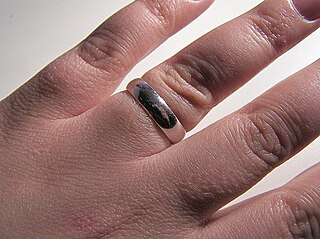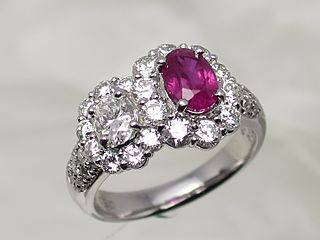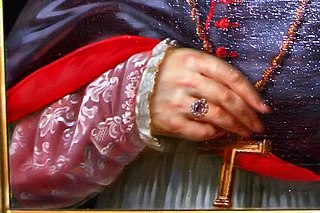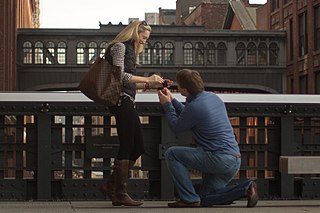
Handfasting is a traditional practice that, depending on the term's usage, may define an unofficiated wedding, a betrothal, or a temporary wedding. The phrase refers to the making fast of a pledge by the shaking or joining of hands.

A hairpin or hair pin is a long device used to hold a person's hair in place. It may be used simply to secure long hair out of the way for convenience or as part of an elaborate hairstyle or coiffure. The earliest evidence for dressing the hair may be seen in carved "Venus figurines" such as the Venus of Brassempouy and the Venus of Willendorf. The creation of different hairstyles, especially among women, seems to be common to all cultures and all periods and many past, and current, societies use hairpins.

A wedding is a ceremony where two people are united in marriage. Wedding traditions and customs vary greatly between cultures, ethnic groups, races, religions, denominations, countries, social classes, and sexual orientations. Most wedding ceremonies involve an exchange of marriage vows by a couple, presentation of a gift, and a public proclamation of marriage by an authority figure or celebrant. Special wedding garments are often worn, and the ceremony is sometimes followed by a wedding reception. Music, poetry, prayers, or readings from religious texts or literature are also commonly incorporated into the ceremony, as well as superstitious customs.

An engagement ring, also known as a betrothal ring, is a ring indicating that the person wearing it is engaged to be married, especially in Western cultures. A ring is presented as an engagement gift by a partner to their prospective spouse when they propose marriage or directly after a marriage proposal is accepted. It represents a formal agreement to future marriage. In most Western countries, engagement rings are worn mostly by women, and rings can feature diamonds or other gemstones. The neologism "mangagement ring" is sometimes used for an engagement ring worn by men. In some cultures, including Northern Europe, both partners wear matching rings, and engagement rings may also be used as wedding rings. In the Anglosphere, the ring is customarily worn on the left hand ring finger, but customs vary considerably elsewhere across the world.

An engagement or betrothal is the period of time between the declaration of acceptance of a marriage proposal and the marriage itself. During this period, a couple is said to be fiancés, betrothed,intended, affianced, engaged to be married, or simply engaged. Future brides and grooms may be called fiancée (feminine) or fiancé (masculine), the betrothed, a wife-to-be or husband-to-be, respectively. The duration of the courtship varies vastly, and is largely dependent on cultural norms or upon the agreement of the parties involved.

A wedding ring or wedding band is a finger ring that indicates that its wearer is married. It is usually forged from metal, traditionally gold or another precious metal. Rings were used in ancient Rome during marriage.

A Claddagh ring is a traditional Irish ring in which a heart represents love, the crown stands for loyalty, and two clasped hands symbolize friendship.

A wedding cake is the traditional cake served at wedding receptions following dinner. In some parts of England, the wedding cake is served at a wedding breakfast; the 'wedding breakfast' does not mean the meal will be held in the morning, but at a time following the ceremony on the same day. In modern Western culture, the cake is usually on display and served to guests at the reception. Traditionally, wedding cakes were made to bring good luck to all guests and the couple. Nowadays, however, they are more of a centerpiece to the wedding and are not always even served to the guests. Some cakes are built with only a single edible tier for the bride and groom to share, but this is rare since the cost difference between fake and real tiers is minimal.

Mehndi is a form of temporary skin decoration using a paste created with henna. In the West, mehndi is commonly known as henna tattoo, although it is not a permanent tattoo.

The ring finger, third finger, fourth finger, leech finger, or annulary is the fourth digit of the human hand, located between the middle finger and the little finger.
Visual markers of marital status, as well as social status, may include clothing, hairstyle, accessories, jewelry, tattoos, and other bodily adornments. Visual markers of marital status are particularly important because they indicate that a person should not be approached for flirtation, courtship, or sex. In some cultures, married people enjoy special privileges or are addressed differently by members of the community.

A ring is a round band, usually made of metal, worn as ornamental jewelry. The term "ring" by itself denotes jewellery worn on the finger; when worn as an ornament elsewhere, the body part is specified within the term, e.g., earrings, neck rings, arm rings, and toe rings. Rings fit snugly around or in the part of the body they ornament, so bands worn loosely, like a bracelet, are not rings. Rings may be made of almost any hard material: wood, bone, stone, metal, glass, jade, gemstone or plastic. They may be set with gemstones or with other types of stone or glass.

Sprang is an ancient method of constructing fabric that has a natural elasticity. Its appearance is similar to netting, but unlike netting, sprang is constructed entirely from warp threads. Archaeological evidence indicates that sprang predates knitting; the two needlework forms bear a visible resemblance and serve similar functions but require different production techniques.

An ecclesiastical ring is a finger ring worn by clergy, such as a bishop's ring.

A marriage proposal is a custom or ritual, common in Western cultures, in which one member of a couple asks the other for their hand in marriage. If accepted, it marks the initiation of engagement, a mutual promise of later marriage.

The hamsa, also known as the hand ofFatima, is a palm-shaped amulet popular throughout North Africa and in the Middle East and commonly used in jewellery and wall hangings. Depicting the open hand, an image recognized and used as a sign of protection in many times throughout history, the hamsa has been traditionally believed to provide defense against the evil eye.

Erusin is the Hebrew term for betrothal. In modern Hebrew, "erusin" means engagement, but this is not the historical meaning of the term, which is the first part of marriage.

The Azerbaijani wedding tradition is one of the most significant and solemn family traditions of Azerbaijani people. It is multi-stepped, and is related to various compulsory rituals and traditions. Ancient Azerbaijani weddings reflect cycles of traditions, lasting for a long period of time, and need significant material costs.
A smart ring is a compact wearable electronic device that combines mobile technology with features for convenient on-the-go use. These devices, typically designed to fit on a finger like a traditional ring, offer functionalities like mobile payments, access control, gesture control, and activity tracking. Smart rings can connect to smartphones or other devices, and some can operate independently, communicating with cloud-based systems or performing standalone tasks. While lacking traditional displays, they respond to contextual cues, such as proximity to payment terminals or specific gestures.

Weddings in ancient Rome were a sacred ritual involving many religious practices. In order for the wedding to take place the bride and the groom or their fathers needed to consent to the wedding. Generally, the wedding would take place in June due to the god Juno. Weddings would never take place on days that were considered unlucky. During the wedding the groom would pretend to kidnap the bride. This was done to convince the household guardians, or lares, that the bride did not go willingly. Afterwards, the bride and the groom had their first sexual experiences on a couch called a lectus. In a Roman wedding both sexes had to wear specific clothing. Boys had to wear the toga virilis while the bride to wear a wreath, a veil, a yellow hairnet, chaplets of roses, seni crines, and the hasta caelibaris. All of the guests would wear the same clothes as the groom and the bride. The Romans believed that if bad omens showed up during a wedding it would indicate the couple was evil or unlucky. In order for a marriage to be successful there needed to be no evil omens and everyone must follow the traditional customs.


















